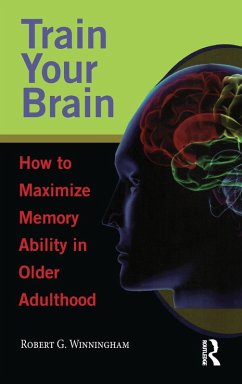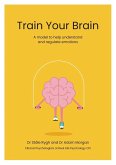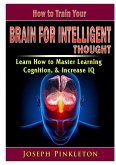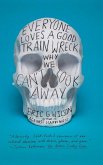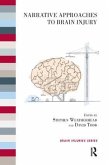- Gebundenes Buch
- Merkliste
- Auf die Merkliste
- Bewerten Bewerten
- Teilen
- Produkt teilen
- Produkterinnerung
- Produkterinnerung
Suitable for older adults, and the people who work with them, this title offers practical and scientifically based suggestions and interventions on how to maintain and improve memory ability. It contains cognitive enhancement activities, with instructions, that can be used to create a memory enhancement program for oneself or others.
Andere Kunden interessierten sich auch für
![How to Think and Intervene Like an REBT Therapist How to Think and Intervene Like an REBT Therapist]() Windy DrydenHow to Think and Intervene Like an REBT Therapist158,99 €
Windy DrydenHow to Think and Intervene Like an REBT Therapist158,99 €![Train Your Brain Train Your Brain]() Staale RyghTrain Your Brain21,99 €
Staale RyghTrain Your Brain21,99 €![How to Train Your Brain for Intelligent Thought Learn How to Master Learning, Cognition, & Increase IQ How to Train Your Brain for Intelligent Thought Learn How to Master Learning, Cognition, & Increase IQ]() Joseph PinkletonHow to Train Your Brain for Intelligent Thought Learn How to Master Learning, Cognition, & Increase IQ12,99 €
Joseph PinkletonHow to Train Your Brain for Intelligent Thought Learn How to Master Learning, Cognition, & Increase IQ12,99 €![Memory How to Develop, Train, and Use It Memory How to Develop, Train, and Use It]() William Walker AtkinsonMemory How to Develop, Train, and Use It30,99 €
William Walker AtkinsonMemory How to Develop, Train, and Use It30,99 €![Everyone Loves a Good Train Wreck Everyone Loves a Good Train Wreck]() Eric G. WilsonEveryone Loves a Good Train Wreck15,99 €
Eric G. WilsonEveryone Loves a Good Train Wreck15,99 €![Narrative Approaches to Brain Injury Narrative Approaches to Brain Injury]() Narrative Approaches to Brain Injury50,99 €
Narrative Approaches to Brain Injury50,99 €![Therapeutic Interventions in Three Sentences Therapeutic Interventions in Three Sentences]() Stefan HammelTherapeutic Interventions in Three Sentences62,99 €
Stefan HammelTherapeutic Interventions in Three Sentences62,99 €-
-
-
Suitable for older adults, and the people who work with them, this title offers practical and scientifically based suggestions and interventions on how to maintain and improve memory ability. It contains cognitive enhancement activities, with instructions, that can be used to create a memory enhancement program for oneself or others.
Produktdetails
- Produktdetails
- Verlag: Routledge
- Seitenzahl: 264
- Erscheinungstermin: 15. Januar 2010
- Englisch
- Abmessung: 235mm x 157mm x 19mm
- Gewicht: 538g
- ISBN-13: 9780895033499
- ISBN-10: 0895033496
- Artikelnr.: 57054447
- Herstellerkennzeichnung
- Libri GmbH
- Europaallee 1
- 36244 Bad Hersfeld
- gpsr@libri.de
- Verlag: Routledge
- Seitenzahl: 264
- Erscheinungstermin: 15. Januar 2010
- Englisch
- Abmessung: 235mm x 157mm x 19mm
- Gewicht: 538g
- ISBN-13: 9780895033499
- ISBN-10: 0895033496
- Artikelnr.: 57054447
- Herstellerkennzeichnung
- Libri GmbH
- Europaallee 1
- 36244 Bad Hersfeld
- gpsr@libri.de
Robert G. Winningham, Western Oregon University
Chapter 1. Introduction: Can Memory Ability be Improved?
The idea that memory ability can be improved is presented and supported.
Research is showing that our memory and cognitive abilities are affected by
controllable lifestyle factors.
Chapter 2. How Memory Works
The reader will learn the basic facts and theories about memory. These
ideas reappear throughout the book and will help the reader understand
subsequent chapters at a deeper level.
Chapter 3. How the Brain Works
This chapter provides a basic description of how the brain works, in
particular how it makes, stores, and retrieves memories. This information
will allow the reader to understand what happens to the brain (and memory)
as we age, which will enable them to understand why we need to do certain
types of memory enhancement activities.
Chapter 4. Use It or Lose It
The Use It or Lose It theory of memory and aging will show the reader how
important it is to stay mentally active. In addition to looking at the
plethora of research that supports the idea that staying mentally active
will decrease one's chance of having memory problems, this chapter also
contains a long list of activities that people can do to stay mentally
active and cognitively sharp.
Chapter 5. Nutrition
The nutrition chapter details how what we eat can either increase or
decrease the likelihood of developing memory problems. Lists of foods that
are good for maintaining a healthy brain are presented.
Chapter 6. Physical Exercise
Maximizing memory ability and decreasing the chance of developing dementia
requires a holistic approach and physical exercise is a key component to
maintaining good cognitive abilities. In this chapter, the reader will
learn how exercise affects our memory and attention abilities and which
types of exercises are best for preventing dementia.
Chapter 7. Mood and Social Support
This chapter was written to provide people with information about
depression and aging, including the symptoms, treatments, and its affect on
memory ability. In addition, the topic of social support and aging is
covered and practical interventions are suggested.
Chapter 8. Stress and Memory
Information about the effects of stress on memory and why stress usually
impairs memory ability are presented. The reader is also provided with
practical suggestions to reduce stress and improve memory ability.
Chapter 9. Sleep and Memory
Many types of sleep disorders may impact memory ability. This chapter
focuses on those disorders, their impact on memory, and possible
treatments, which may improve sleep and memory ability.
Chapter 10. Practical Tips
Twelve useful and practical tips to improve memory are presented. These
simple, research based suggestions can dramatically improve people's
ability to make, retain, and recall memories.
Chapter 11. What is Dementia?
This chapter contains information about the various types of dementia and
their precursor conditions and risk factors. The reader will also learn
about the available pharmacological treatments for dementia.
Chapter 12. Creating Your Own Cognitive Enhancement Classes
This unique chapter contains a large number of cognitively stimulating
activities that can be used to create your own cognitive enhancement
program. Ideas about how to customize the activities for people of varying
cognitive abilities are also included.
Chapter 13. Starting and Sustaining Your Cognitive Enhancement Program
This chapter includes information about where classes can be held, how to
charge participants for your time, and materials. We will also explore
which types of participants benefit the most from memory classes and which
type of participants can negatively impact the ability of other
participants to benefit from the classes.
Chapter 14. Participant Management: How to Help More People Benefit from
Cognitive Stimulation
This chapter contains ideas and strategies to maximally stimulate higher
functioning older adults as well those who have more severe memory
impairment or even early stage dementia. Additionally, information about
motivating people to take the necessary steps to improve their memory
ability and quality of life is presented.
References
Appendices
The idea that memory ability can be improved is presented and supported.
Research is showing that our memory and cognitive abilities are affected by
controllable lifestyle factors.
Chapter 2. How Memory Works
The reader will learn the basic facts and theories about memory. These
ideas reappear throughout the book and will help the reader understand
subsequent chapters at a deeper level.
Chapter 3. How the Brain Works
This chapter provides a basic description of how the brain works, in
particular how it makes, stores, and retrieves memories. This information
will allow the reader to understand what happens to the brain (and memory)
as we age, which will enable them to understand why we need to do certain
types of memory enhancement activities.
Chapter 4. Use It or Lose It
The Use It or Lose It theory of memory and aging will show the reader how
important it is to stay mentally active. In addition to looking at the
plethora of research that supports the idea that staying mentally active
will decrease one's chance of having memory problems, this chapter also
contains a long list of activities that people can do to stay mentally
active and cognitively sharp.
Chapter 5. Nutrition
The nutrition chapter details how what we eat can either increase or
decrease the likelihood of developing memory problems. Lists of foods that
are good for maintaining a healthy brain are presented.
Chapter 6. Physical Exercise
Maximizing memory ability and decreasing the chance of developing dementia
requires a holistic approach and physical exercise is a key component to
maintaining good cognitive abilities. In this chapter, the reader will
learn how exercise affects our memory and attention abilities and which
types of exercises are best for preventing dementia.
Chapter 7. Mood and Social Support
This chapter was written to provide people with information about
depression and aging, including the symptoms, treatments, and its affect on
memory ability. In addition, the topic of social support and aging is
covered and practical interventions are suggested.
Chapter 8. Stress and Memory
Information about the effects of stress on memory and why stress usually
impairs memory ability are presented. The reader is also provided with
practical suggestions to reduce stress and improve memory ability.
Chapter 9. Sleep and Memory
Many types of sleep disorders may impact memory ability. This chapter
focuses on those disorders, their impact on memory, and possible
treatments, which may improve sleep and memory ability.
Chapter 10. Practical Tips
Twelve useful and practical tips to improve memory are presented. These
simple, research based suggestions can dramatically improve people's
ability to make, retain, and recall memories.
Chapter 11. What is Dementia?
This chapter contains information about the various types of dementia and
their precursor conditions and risk factors. The reader will also learn
about the available pharmacological treatments for dementia.
Chapter 12. Creating Your Own Cognitive Enhancement Classes
This unique chapter contains a large number of cognitively stimulating
activities that can be used to create your own cognitive enhancement
program. Ideas about how to customize the activities for people of varying
cognitive abilities are also included.
Chapter 13. Starting and Sustaining Your Cognitive Enhancement Program
This chapter includes information about where classes can be held, how to
charge participants for your time, and materials. We will also explore
which types of participants benefit the most from memory classes and which
type of participants can negatively impact the ability of other
participants to benefit from the classes.
Chapter 14. Participant Management: How to Help More People Benefit from
Cognitive Stimulation
This chapter contains ideas and strategies to maximally stimulate higher
functioning older adults as well those who have more severe memory
impairment or even early stage dementia. Additionally, information about
motivating people to take the necessary steps to improve their memory
ability and quality of life is presented.
References
Appendices
Chapter 1. Introduction: Can Memory Ability be Improved?
The idea that memory ability can be improved is presented and supported.
Research is showing that our memory and cognitive abilities are affected by
controllable lifestyle factors.
Chapter 2. How Memory Works
The reader will learn the basic facts and theories about memory. These
ideas reappear throughout the book and will help the reader understand
subsequent chapters at a deeper level.
Chapter 3. How the Brain Works
This chapter provides a basic description of how the brain works, in
particular how it makes, stores, and retrieves memories. This information
will allow the reader to understand what happens to the brain (and memory)
as we age, which will enable them to understand why we need to do certain
types of memory enhancement activities.
Chapter 4. Use It or Lose It
The Use It or Lose It theory of memory and aging will show the reader how
important it is to stay mentally active. In addition to looking at the
plethora of research that supports the idea that staying mentally active
will decrease one's chance of having memory problems, this chapter also
contains a long list of activities that people can do to stay mentally
active and cognitively sharp.
Chapter 5. Nutrition
The nutrition chapter details how what we eat can either increase or
decrease the likelihood of developing memory problems. Lists of foods that
are good for maintaining a healthy brain are presented.
Chapter 6. Physical Exercise
Maximizing memory ability and decreasing the chance of developing dementia
requires a holistic approach and physical exercise is a key component to
maintaining good cognitive abilities. In this chapter, the reader will
learn how exercise affects our memory and attention abilities and which
types of exercises are best for preventing dementia.
Chapter 7. Mood and Social Support
This chapter was written to provide people with information about
depression and aging, including the symptoms, treatments, and its affect on
memory ability. In addition, the topic of social support and aging is
covered and practical interventions are suggested.
Chapter 8. Stress and Memory
Information about the effects of stress on memory and why stress usually
impairs memory ability are presented. The reader is also provided with
practical suggestions to reduce stress and improve memory ability.
Chapter 9. Sleep and Memory
Many types of sleep disorders may impact memory ability. This chapter
focuses on those disorders, their impact on memory, and possible
treatments, which may improve sleep and memory ability.
Chapter 10. Practical Tips
Twelve useful and practical tips to improve memory are presented. These
simple, research based suggestions can dramatically improve people's
ability to make, retain, and recall memories.
Chapter 11. What is Dementia?
This chapter contains information about the various types of dementia and
their precursor conditions and risk factors. The reader will also learn
about the available pharmacological treatments for dementia.
Chapter 12. Creating Your Own Cognitive Enhancement Classes
This unique chapter contains a large number of cognitively stimulating
activities that can be used to create your own cognitive enhancement
program. Ideas about how to customize the activities for people of varying
cognitive abilities are also included.
Chapter 13. Starting and Sustaining Your Cognitive Enhancement Program
This chapter includes information about where classes can be held, how to
charge participants for your time, and materials. We will also explore
which types of participants benefit the most from memory classes and which
type of participants can negatively impact the ability of other
participants to benefit from the classes.
Chapter 14. Participant Management: How to Help More People Benefit from
Cognitive Stimulation
This chapter contains ideas and strategies to maximally stimulate higher
functioning older adults as well those who have more severe memory
impairment or even early stage dementia. Additionally, information about
motivating people to take the necessary steps to improve their memory
ability and quality of life is presented.
References
Appendices
The idea that memory ability can be improved is presented and supported.
Research is showing that our memory and cognitive abilities are affected by
controllable lifestyle factors.
Chapter 2. How Memory Works
The reader will learn the basic facts and theories about memory. These
ideas reappear throughout the book and will help the reader understand
subsequent chapters at a deeper level.
Chapter 3. How the Brain Works
This chapter provides a basic description of how the brain works, in
particular how it makes, stores, and retrieves memories. This information
will allow the reader to understand what happens to the brain (and memory)
as we age, which will enable them to understand why we need to do certain
types of memory enhancement activities.
Chapter 4. Use It or Lose It
The Use It or Lose It theory of memory and aging will show the reader how
important it is to stay mentally active. In addition to looking at the
plethora of research that supports the idea that staying mentally active
will decrease one's chance of having memory problems, this chapter also
contains a long list of activities that people can do to stay mentally
active and cognitively sharp.
Chapter 5. Nutrition
The nutrition chapter details how what we eat can either increase or
decrease the likelihood of developing memory problems. Lists of foods that
are good for maintaining a healthy brain are presented.
Chapter 6. Physical Exercise
Maximizing memory ability and decreasing the chance of developing dementia
requires a holistic approach and physical exercise is a key component to
maintaining good cognitive abilities. In this chapter, the reader will
learn how exercise affects our memory and attention abilities and which
types of exercises are best for preventing dementia.
Chapter 7. Mood and Social Support
This chapter was written to provide people with information about
depression and aging, including the symptoms, treatments, and its affect on
memory ability. In addition, the topic of social support and aging is
covered and practical interventions are suggested.
Chapter 8. Stress and Memory
Information about the effects of stress on memory and why stress usually
impairs memory ability are presented. The reader is also provided with
practical suggestions to reduce stress and improve memory ability.
Chapter 9. Sleep and Memory
Many types of sleep disorders may impact memory ability. This chapter
focuses on those disorders, their impact on memory, and possible
treatments, which may improve sleep and memory ability.
Chapter 10. Practical Tips
Twelve useful and practical tips to improve memory are presented. These
simple, research based suggestions can dramatically improve people's
ability to make, retain, and recall memories.
Chapter 11. What is Dementia?
This chapter contains information about the various types of dementia and
their precursor conditions and risk factors. The reader will also learn
about the available pharmacological treatments for dementia.
Chapter 12. Creating Your Own Cognitive Enhancement Classes
This unique chapter contains a large number of cognitively stimulating
activities that can be used to create your own cognitive enhancement
program. Ideas about how to customize the activities for people of varying
cognitive abilities are also included.
Chapter 13. Starting and Sustaining Your Cognitive Enhancement Program
This chapter includes information about where classes can be held, how to
charge participants for your time, and materials. We will also explore
which types of participants benefit the most from memory classes and which
type of participants can negatively impact the ability of other
participants to benefit from the classes.
Chapter 14. Participant Management: How to Help More People Benefit from
Cognitive Stimulation
This chapter contains ideas and strategies to maximally stimulate higher
functioning older adults as well those who have more severe memory
impairment or even early stage dementia. Additionally, information about
motivating people to take the necessary steps to improve their memory
ability and quality of life is presented.
References
Appendices

